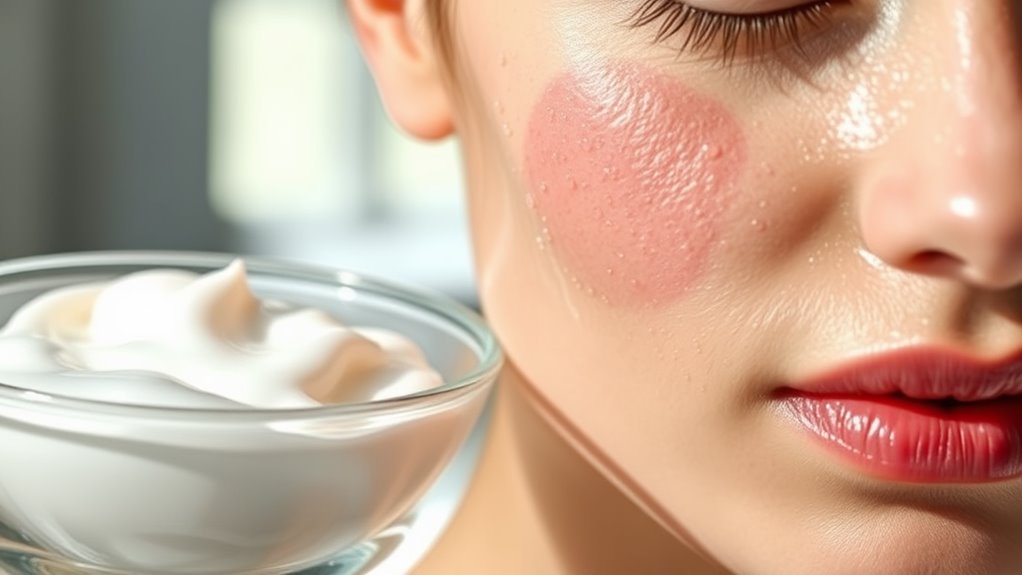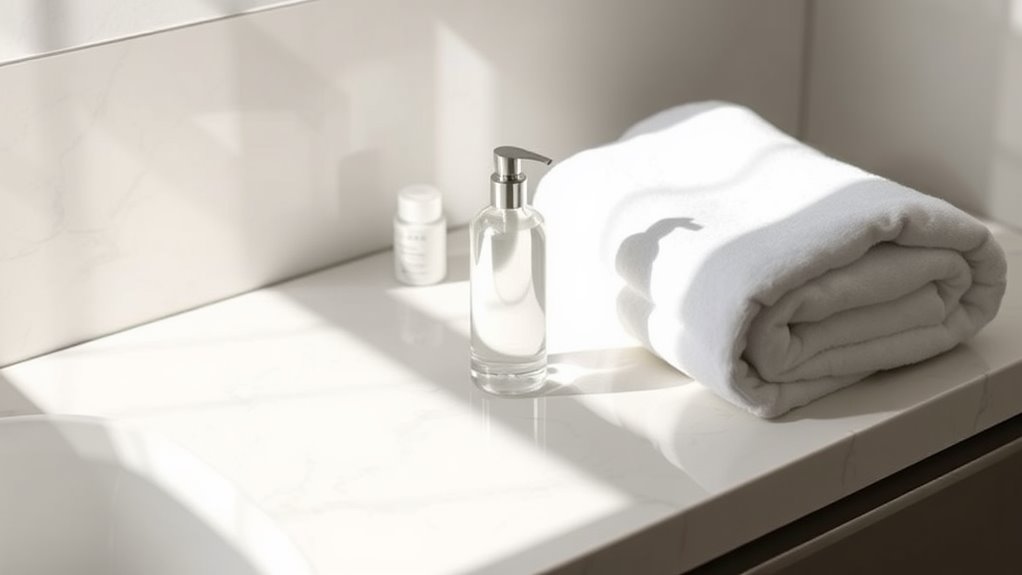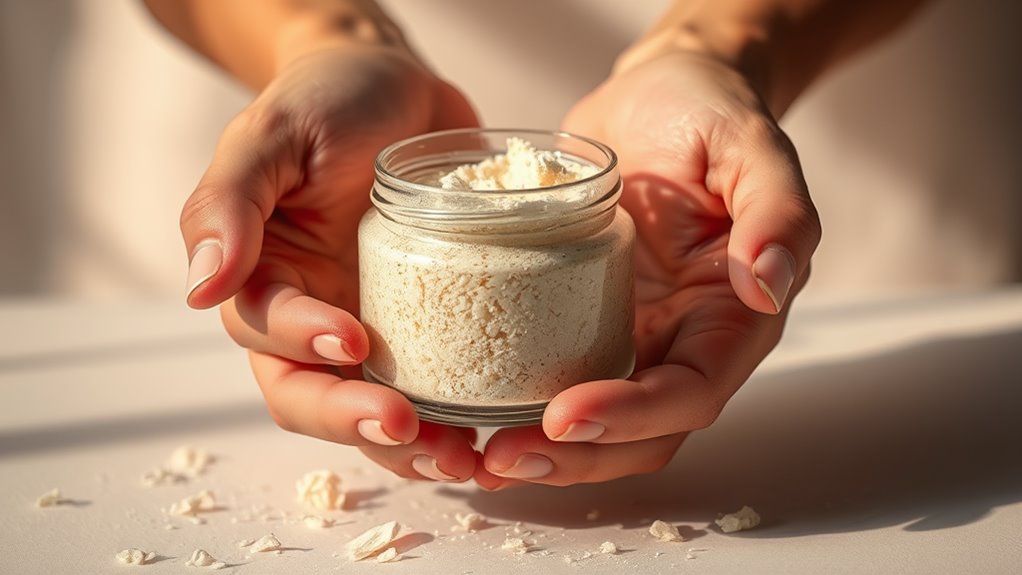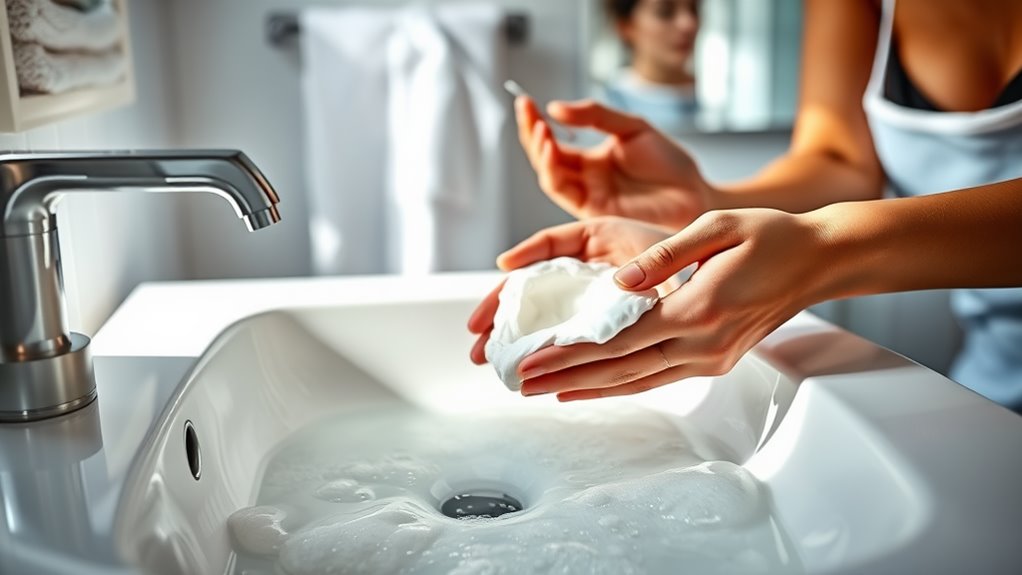How to Tell If Your Cleanser Is Too Strong for Your Skin
If your cleanser is too strong for your skin, you’ll likely notice signs like tightness, redness, or dryness after washing. These symptoms indicate potential irritation or damage to your skin barrier. You might also experience increased sensitivity or breakouts as your skin compensates for lost moisture. Choosing a gentler cleanser can help maintain balance and hydration. To learn how to identify the right product for your skin type, continue exploring your options.
Key Takeaways
- Tightness after cleansing indicates your skin may be stripped of essential moisture, suggesting the cleanser may be too harsh.
- Persistent redness or irritation points to inflammation, a sign that the cleanser is irritating your skin.
- Increased breakouts can occur as skin compensates for lost moisture, indicating over-cleansing from a strong cleanser.
- Dry or peeling patches on the skin suggest disruption of the skin barrier due to a harsh cleansing product.
- If you notice heightened sensitivity to other products, it may be a reaction to an overly strong cleanser affecting your skin’s balance.
Understanding Skin Types
To effectively choose a cleanser, it’s crucial to understand your skin type, as this knowledge directly influences how your skin reacts to various products.
Different skin types—oily, dry, combination, and sensitive—require tailored approaches. For instance, if you have oily skin, you might lean towards gel-based cleansers that can combat excess oil without over-drying.
Conversely, if your skin is dry or sensitive, a gentle cream or hydrating cleanser would be more appropriate. It’s important to consider that skin type variations can significantly impact the effectiveness of a cleanser.
Always heed a harsh cleanser warning; using the wrong product can exacerbate issues like irritation or redness.
Common Ingredients in Cleansers
Understanding the common ingredients in cleansers is essential for making informed choices about your skincare.
Familiarizing yourself with these components can help you select a product that suits your skin type and needs. Here are some common ingredients you might encounter:
-
Surfactants: These help to remove dirt and oil effectively.
-
Moisturizers: Ingredients like glycerin or hyaluronic acid keep your skin hydrated.
-
Exfoliants: Chemical exfoliants such as AHA or BHA can enhance skin texture.
-
Fragrances: While they can make products smell pleasant, they might irritate sensitive skin.
Additionally, using a gentle cleanser can prevent damage to your skin barrier.
Signs of Over-Cleansing
Have you ever noticed your skin feeling tight or overly dry after washing? These sensations could be signs of over-cleansing. Other indicators include increased sensitivity, redness, and breakouts, which may arise as your skin attempts to compensate for lost moisture. Over-cleansing can also lead to a disrupted skin barrier, making it crucial to recognize these signs early.
| Sign of Over-Cleansing | Description | Action to Take |
|---|---|---|
| Tightness | Skin feels constricted | Reduce cleansing frequency |
| Redness | Inflammation appears | Switch to a gentler cleanser |
| Breakouts | Acne flare-ups occur | Assess product ingredients |
If you’re experiencing these symptoms, it’s essential to evaluate your cleansing routine. Simplifying your regimen can help restore balance and vitality to your skin.
The Role of Ph in Skin Health
Understanding the pH of your skin is crucial for maintaining its health. An imbalance can lead to issues like dryness or irritation, while the ideal pH range helps protect your skin’s barrier. Let’s explore how the right pH contributes to your overall skin wellness. Additionally, using a cleanser with a balanced pH level can help prevent these skin concerns and promote a healthier complexion.
Importance of Skin Ph
While maintaining the right pH balance is crucial for skin health, many people overlook its significance when choosing skincare products.
Understanding the importance of skin pH can empower you to make better choices for your regimen. Here’s why skin pH matters:
-
Protects the skin barrier: A balanced pH supports the lipid barrier, preventing moisture loss.
-
Affects product efficacy: The effectiveness of active ingredients can be compromised at the wrong pH.
-
Prevents irritation: Products with extreme pH levels can lead to redness and discomfort.
-
Supports microbiome health: A balanced pH fosters a healthy skin microbiome, crucial for defense against pathogens.
Effects of Ph Imbalance
An imbalance in skin pH can lead to several adverse effects that compromise your skin’s health. When your skin’s pH strays too far from its optimal level, it can disrupt the skin barrier, making it more susceptible to irritants and pathogens.
You might notice increased dryness, redness, or breakouts as your skin struggles to maintain its natural moisture. Additionally, this imbalance can trigger overproduction of oil, leading to clogged pores and acne.
Sensitive skin may become more reactive, resulting in inflammation and discomfort. Ultimately, a compromised pH level can hinder your skin’s ability to heal and regenerate, making it essential to choose a cleanser that respects your skin’s natural balance for optimal health and appearance.
Ideal Ph Range
Maintaining the ideal pH range for your skin is vital for overall health and appearance. Typically, healthy skin sits between a pH of 4.5 and 5.5. When your skin’s pH strays from this range, it can lead to various issues.
Here are key points to consider:
-
Barrier Function: A balanced pH supports the skin’s barrier, preventing moisture loss.
-
Bacterial Balance: Optimal pH helps maintain a healthy microbiome, minimizing harmful bacteria.
-
Product Efficacy: Skincare products work best at the right pH, enhancing their effectiveness.
-
Inflammation Reduction: Balanced pH can lower the risk of irritation and redness.
Effects of Stripping Natural Oils
Stripping your skin’s natural oils can lead to various signs of imbalance, such as dryness, irritation, and increased sensitivity.
When your cleanser is too harsh, it disrupts the delicate equilibrium essential for healthy skin. Understanding these effects is crucial for maintaining optimal skin health and choosing the right products. Additionally, using a gentle cleanser can help ensure hydration without over-drying your skin.
Signs of Oil Stripping
When your cleanser is too strong, you might notice several signs indicating that it’s stripping your skin’s natural oils.
Recognizing these signs early can help you adjust your skincare routine for better results. Here are some key indicators to watch for:
- Your skin feels tight or dry shortly after cleansing.
- You experience increased sensitivity or irritation.
- You notice an unusual amount of flakiness or rough patches.
- Your skin produces excess oil in response to the dryness.
Pay attention to these symptoms, as they signal that your cleanser may be too harsh.
Adjusting your product choice can restore balance and comfort to your skin, allowing it to function optimally.
Balance and Skin Health
Your skin’s balance is crucial for overall health, as it relies on natural oils to maintain hydration and protect against environmental aggressors.
When your cleanser strips these oils, you compromise this balance, leading to dryness, irritation, and increased sensitivity. Skin may overcompensate by producing more oil, resulting in clogged pores and breakouts.
A well-formulated cleanser should cleanse without disrupting your skin’s protective barrier. Look for products that contain gentle surfactants and nourishing ingredients that support your skin’s natural function.
If your skin feels tight or looks dull after cleansing, it’s a sign your cleanser may be too harsh. Prioritize gentle formulations to ensure your skin remains balanced, hydrated, and healthy.
Your skin will thank you for it!
Symptoms of Irritation and Inflammation
Have you noticed redness or a burning sensation on your skin after cleansing? These may be signs that your cleanser is too strong for your skin.
It’s essential to recognize the symptoms of irritation and inflammation to maintain healthy skin. Here are some key indicators:
- Persistent dryness or tightness
- Flaking or peeling skin
- Increased sensitivity to products
- Swelling or bumps on the skin
If you’re experiencing any of these symptoms, it’s a clear signal that your cleanser may be disrupting your skin’s barrier.
Consider switching to a gentler formulation, and pay attention to how your skin responds.
Mastering your skincare routine requires tuning into these warning signs for optimal skin health.
Changes in Skin Texture
As you evaluate your skin’s response to cleansing, noticeable changes in texture can signal that your cleanser is too harsh.
If you start experiencing roughness, flakiness, or a tight sensation, these are strong indicators that your product may be stripping away essential moisture. You might also notice an increase in sensitivity, which can manifest as bumps or a grainy feel.
These texture changes suggest that your skin’s natural barrier is compromised, leading to uneven skin. It’s crucial to pay attention to how your skin reacts after cleansing.
If you observe persistent changes, consider switching to a milder formula. Your skin deserves a cleanser that maintains its integrity while effectively removing impurities.
Prioritize texture stability for optimal skin health.
The Impact on Skin Barrier Function
When a cleanser is too strong, it can significantly disrupt your skin’s barrier function, leading to a host of issues.
A compromised barrier can result in increased sensitivity, dryness, and susceptibility to irritation. You might notice:
- Dry patches that refuse to heal
- Redness that lingers longer than usual
- Breakouts due to an imbalance in skin flora
- Increased sensitivity to other products
Understanding the impact on your skin’s barrier is crucial for effective skincare.
A weakened barrier not only hampers your skin’s ability to retain moisture but also leaves it vulnerable to environmental aggressors.
How to Perform a Patch Test
To ensure your cleanser is safe for your skin, start by selecting a discreet test area, like your inner forearm.
Apply the product sparingly and wait to see if any reactions occur.
Monitoring this area for redness, irritation, or discomfort will help you determine if the cleanser is suitable for your skin.
Select Test Area
Choosing the right test area is crucial for performing an effective patch test. You want to select a spot that’s discreet yet representative of your skin’s sensitivity.
Here are some ideal locations:
-
Inside of your wrist: This area is sensitive and often reacts well to products.
-
Behind your ear: The skin here is thin and can mimic facial reactions.
-
Inner elbow: This spot allows you to observe any reactions in a hidden area.
-
Side of your neck: It’s a good indicator of how your skin will respond on your face.
Apply Product Sparingly
After selecting your test area, it’s time to apply the product sparingly.
Use a clean cotton swab or your fingertip to dispense a small amount of the cleanser. Focus on the chosen spot, ensuring you cover it lightly without over-saturating the skin. Applying too much product can lead to misleading results, so less is more in this scenario.
Make sure the application is even, and avoid any rubbing or massaging; you want to mimic the way you’ll use the cleanser during your regular routine. Remember, this is just a test, so precision is key.
Monitor for Reactions
While you wait for your cleanser to settle on the skin, it’s crucial to monitor for any reactions that may indicate a product is too strong.
Performing a patch test can help you identify potential issues before applying your cleanser to your entire face.
- Look for redness or irritation in the tested area.
- Note any stinging or burning sensations that occur.
- Watch for excessive dryness or peeling after use.
- Check for breakouts or an increase in blemishes.
If you notice any of these reactions, it’s a sign your cleanser may be too harsh.
Consider switching to a gentler formulation, and always consult with a skincare professional if you’re unsure about your product choices.
Alternatives to Harsh Cleansers
If your current cleanser feels harsh on your skin, consider exploring gentler alternatives that can effectively cleanse without causing irritation.
Look for sulfate-free cleansers, as they’re less likely to strip your skin’s natural oils. Cream-based or oil-based cleansers can also provide thorough cleansing while maintaining moisture.
Micellar water is another excellent option, offering a mild yet effective way to remove dirt and makeup without harsh ingredients. Additionally, gel cleansers with soothing botanical extracts can cleanse effectively without overwhelming your skin.
Always check ingredient lists for potential irritants and opt for fragrance-free products when possible. By choosing these gentler alternatives, you can maintain your skin’s health while achieving a clean, refreshed complexion.
Recommendations for Gentle Cleansing
When selecting a gentle cleanser, prioritize products that cater to your skin type and avoid harsh ingredients.
Look for formulations that cleanse without stripping your skin’s natural moisture barrier. Here are some recommendations to consider:
-
Cream or lotion-based cleansers: Ideal for dry or sensitive skin, they provide hydration while cleansing.
-
Gel cleansers: Great for oily or combination skin, they effectively remove excess oil without over-drying.
-
Micellar water: A versatile option that’s gentle enough for all skin types, it effectively removes makeup and impurities.
-
Fragrance-free options: These reduce the risk of irritation, making them suitable for sensitive skin.
When to Consult a Dermatologist
Knowing when to consult a dermatologist can make a significant difference in your skincare journey, especially if you experience persistent issues like redness, irritation, or breakouts.
If your skin feels unusually dry, tight, or flaky after cleansing, it’s a sign that your cleanser might be too harsh. Additionally, if you develop new acne, rashes, or other unexplained skin conditions, don’t hesitate to seek professional advice.
A dermatologist can provide tailored recommendations and may identify underlying issues that over-the-counter products can’t address. Remember, your skin’s health is paramount, and early intervention can prevent long-term damage.
Trust your instincts—if something feels off, it’s always best to get expert input to ensure your skin receives the care it deserves.




